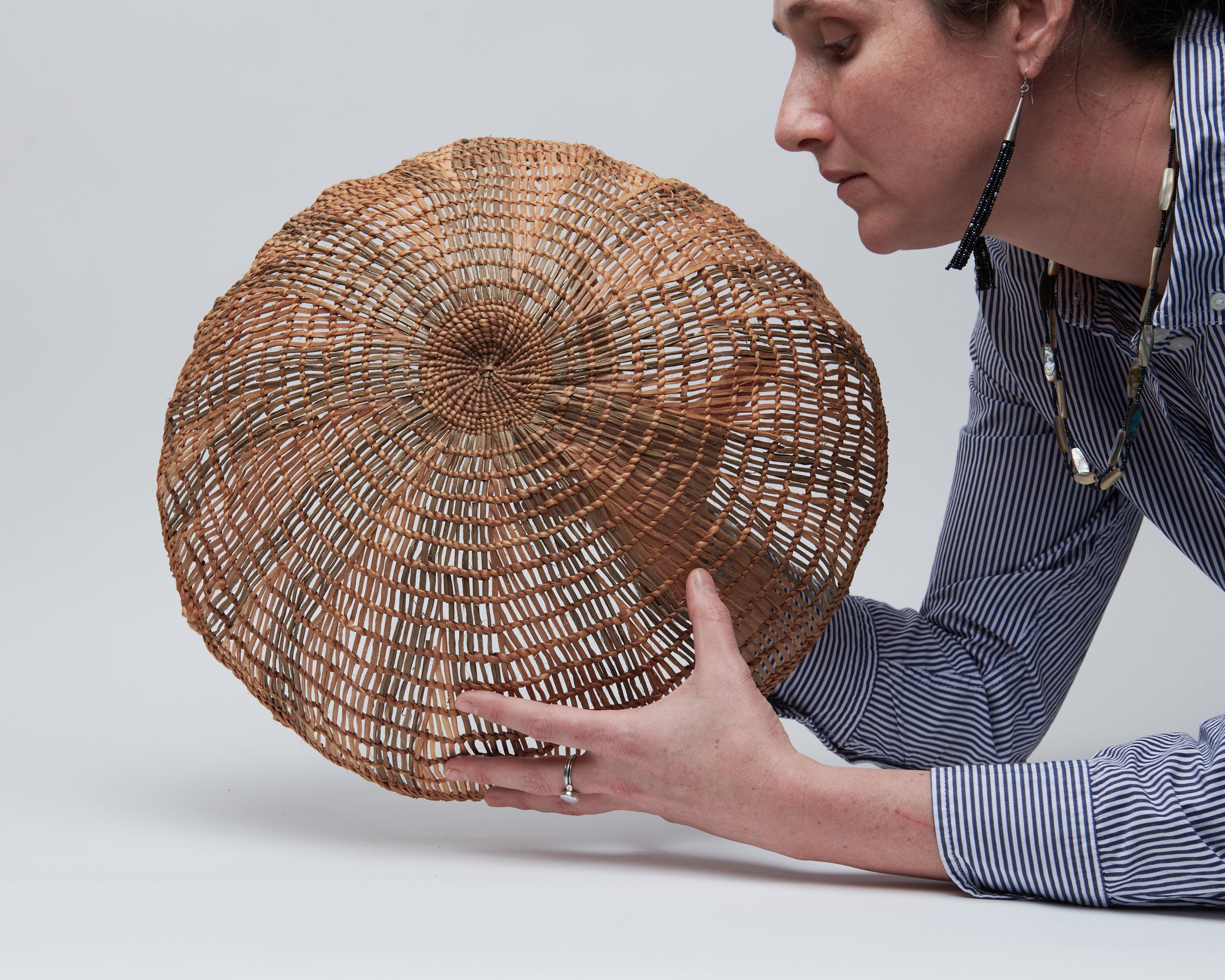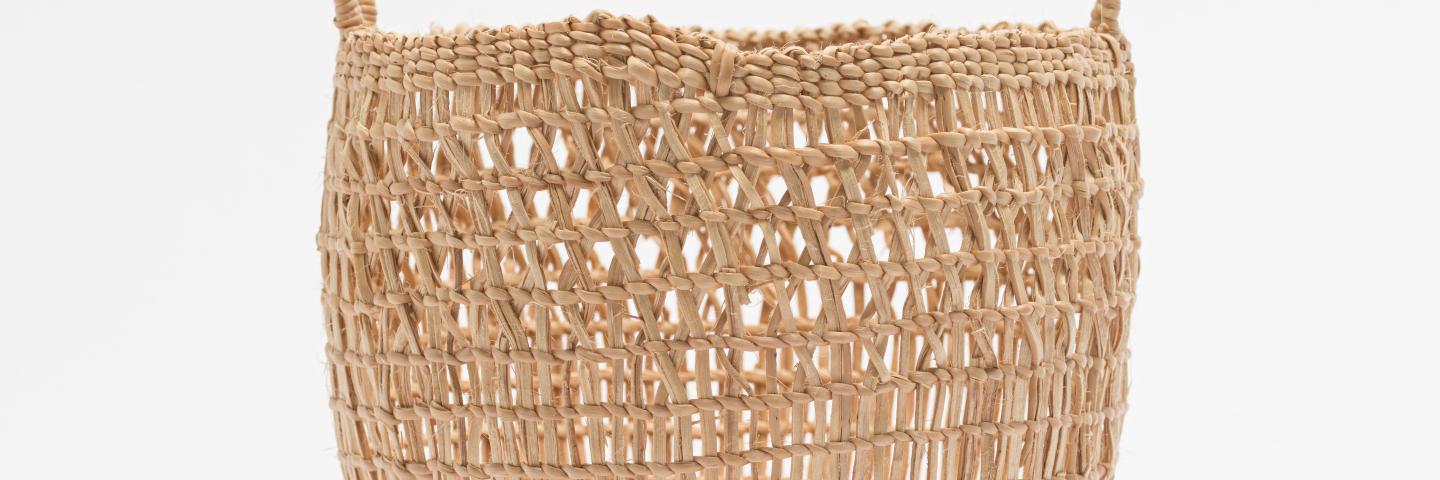 | Traditional Skill/Art Craft: Hanis and Miluk Coos Traditional Basketweaving Years Awarded: 2017 Contact Information: Phone: (503)208-2592 Email: sarasiestreem@hotmail.com |
ARTIST BIOGRAPHY
Sara Siestreem (Hanis Coos) is a multidisciplinary artist who combines painting, photography, printmaking, weaving, and large-scale installation. Her art practice branches into institutional reform as it relates to curatorial and educational practices surrounding Indigenous fine art.
Siestreem was recently awarded the University of Oregon’s 2022-23 CFAR Fellowship and the 2022 Forge Project Fellowship, one of six Indigenous individuals representing a broad diversity of cultural practices, participatory research, organizing models, and geographic contexts that honor Indigenous pasts as well as build Native futures. Her recent exhibitions throughout Oregon include Where the Waters Come Together (group exhibition), Native Arts & Cultures Foundation, Portland; pearly gates, Artist Project Space, Jordan Schnitzer Museum of Art, Eugene; <<<<<<<i love you lucille ball>>>>>>>, ARTspace Gallery, Lake Oswego; and looking for the land///found the weather, Elizabeth Leach Gallery, Portland.
Sara Siestreem (Hanis Coos) was born in 1976. She comes from a family of professional artists and educators; her training began in the home. Her lifelong mentor is Lillian Pitt (Wasco, Warm Springs, Yakama) and her weaving teachers are Greg Archuleta (Grand Ronde) and Greg A. Robinson (Chinook Nation). Siestreem graduated Phi Kappa Phi with a BS from PSU in 2005. She earned an MFA with distinction from Pratt Art Institute in 2007. She is represented by The Elizabeth Leach Gallery, and lives and works in Portland,Oregon.
APPRENTICE BIOGRAPHY - Ashley Russell 2017
Ashley Russell is a Miluk Coos Tribal member who began her work with traditional plants through her job as a Water Protection Specialist in the Natural Resources and Cultural Department for the Coos tribe. She was drawn to certain traditional plants that she could recall the cultural uses for them, this lead her to a workshop given by Sara Siestreem, and began her journey into weaving. She plans to continue the tradition of Coos weaving by planning and hosting gathering and weaving events on the reservation. Through this, she will help Sara achieve her dream of reviving the Coos weaving culture.
Q+A WITH THE MENTOR ARTIST
Describe your traditional art.
Body
I am a Hanis Coos tribal member, enrolled in the Confederated Tribes of Coos, Lower Umpqua, and Siuslaw Indians. I am the weaving teacher for the Coos, Lower Umpqua, and Siuslaw Indians. Our weaving tradition is a dynamic year-round practice that spans from the natural world, our homes, the classroom, tribal government, and outside institutions.
In the field of our ancestral homeland I teach gathering and processing protocols of natural materials indigenous to our region. These lessons span from plant identification, uses, cultivation, mapping, and optimal gathering times for each plant. The study also includes cultural meaning, spiritual practices, sustainability, and safety practices inherent to our tradition. I teach my students about the contemporary political nature of gathering and resource protection, our sovereign rights on the land, and best practices for interfacing with landowners, both private and public.
I teach monthly weaving workshops at our tribal hall in Coos Bay. In workshops, I take my students through the primary components of traditional Coos basketry; all phases of natural materials processing, start-to- finish weaving, creating natural dyes, overlay and plaiting techniques, three-strand twine, closed, open and cross warp weaving techniques, basket architecture and motif, and ceremonial aspects.
How did you come to learn this tradition?
Body
In 2011, I began to study the weaving culture of my people. I created The Hanis Coos Traditional Weaving Research and Education Project. With the support of my tribe and The Evergreen Longhouse, I opened our tribal field to studio weaving education program in 2014.
The study and ongoing research for my program and weaving practice is conducted in museums, with regional knowledge holders, and in the field. I studied with The Grand Ronde under the tutelage of Greg Archuleta and Greg A. Robinson. I have been advised by Gail Tremblay, Pat Courtney Gold, Shan Goshorn, Lillian Pitt, and the late Dr. Teri Rofkar. I have conducted institutional research visits in the collections at UC Berkeley, The Burke Museum, The Maryhill Museum, The Portland Art Museum, The University of Oregon Museum of Natural and Cultural History, The Bandon Pioneer Museum, and The Siuslaw Pioneer Museum.
The practice of this tradition has utterly transformed my work and life path. It is the connection point for the past, present, and future and the vehicle through which I activate my ancestral and cultural inheritance.
Why is this cultural tradition important to your community?
Body
We are Salmon people from the south coast of Oregon. Historically, we were a large and powerful group, rich in natural resources and cultural lifeways.
This was violently disrupted in the 1850s by the United States government. In a few years we were reduced to a handful of people through massacre and disease. Our material culture was destroyed, stolen, or sold out of desperation, almost completely. We were forcibly and repeatedly removed from our land to reservation and our seasonal round (the practice of moving according to the availability and location of desirable food) was disrupted. Cultural practices such as language, ceremony, the arts and traditional education went into hibernation at this time.
My generation is working to reclaim and awaken our cultural practices and identity as well as make our presence known to the mainstream. My contribution to those efforts is in the arts. With institutional collections, I am working to establish a baseline of our historic intellectual and cultural property. In the classroom, I am working to ignite these quantities in the people. In the studio, I am working to create a new line in history that claims all of that and provides new insights to who we are now.
Through all these activities, I am training my community to carry the weaving tradition on in their own lives as well as the places that they have impact; inside our tribal government, families, and community. Together, we are working to integrate our weaving culture back into all aspects of our daily lives and ceremony. This tradition is a very important way for us to connect with one another, the land, and our ancestors.
Experience/Honors
Body
Her work has been shown at Museum of Northwest Art, Missoula Art Museum, Hallie Ford Museum, Jordan Schnitzer Museum of Art, The Whatcom Museum of Arts, The University of Oregon Museum of Natural and Cultural History, Museum of Contemporary Native American Art, Grants Pass Museum of Art, Crow’s Shadow Institute of the Arts, The Art Gallery of Greater Victoria, The Evergreen Longhouse, Newport Visual Arts Center, Spaceworks Gallery, Littman Gallery, Archer Gallery, Royal Nebeker Gallery, Crossroads Carnegie Arts Center, Central Oregon Community College, Oregon State University, 1Spot Gallery (Phoenix AZ), Jacobs Gallery, Columbia City Gallery, Pratt, Mark Wooley Gallery, Modern Zoo, The Life Gallery, Zeitgeist Gallery, Pip Gallery, and City Center Gallery. Her work figures in The Bonneville Power Administration Native Art Collection, Propel Insurance Collection, Crow’s Shadow Institute of the Art Collection, The Hallie Ford Museum, The Missoula Art Museum, Native American Student and Community Center at Portland State, The Portland Art Museum, and the Regional Arts & Culture Council, Portable Works Collections as well as private collections around the world. She lives and works exclusively in the arts in Portland, Oregon.
Awards
2016 Bonita Mestiza Basket awarded second place honor/”Sgwigwial?txw at 20: Building Upon the Past, Visioning Into the Future,” Evergreen Longhouse, Olympia, WA
Visit OFN's Culture Keepers Roster to learn more about the artist.
Traditional Arts Apprenticeship Program
More OFN programs
OFN main page
